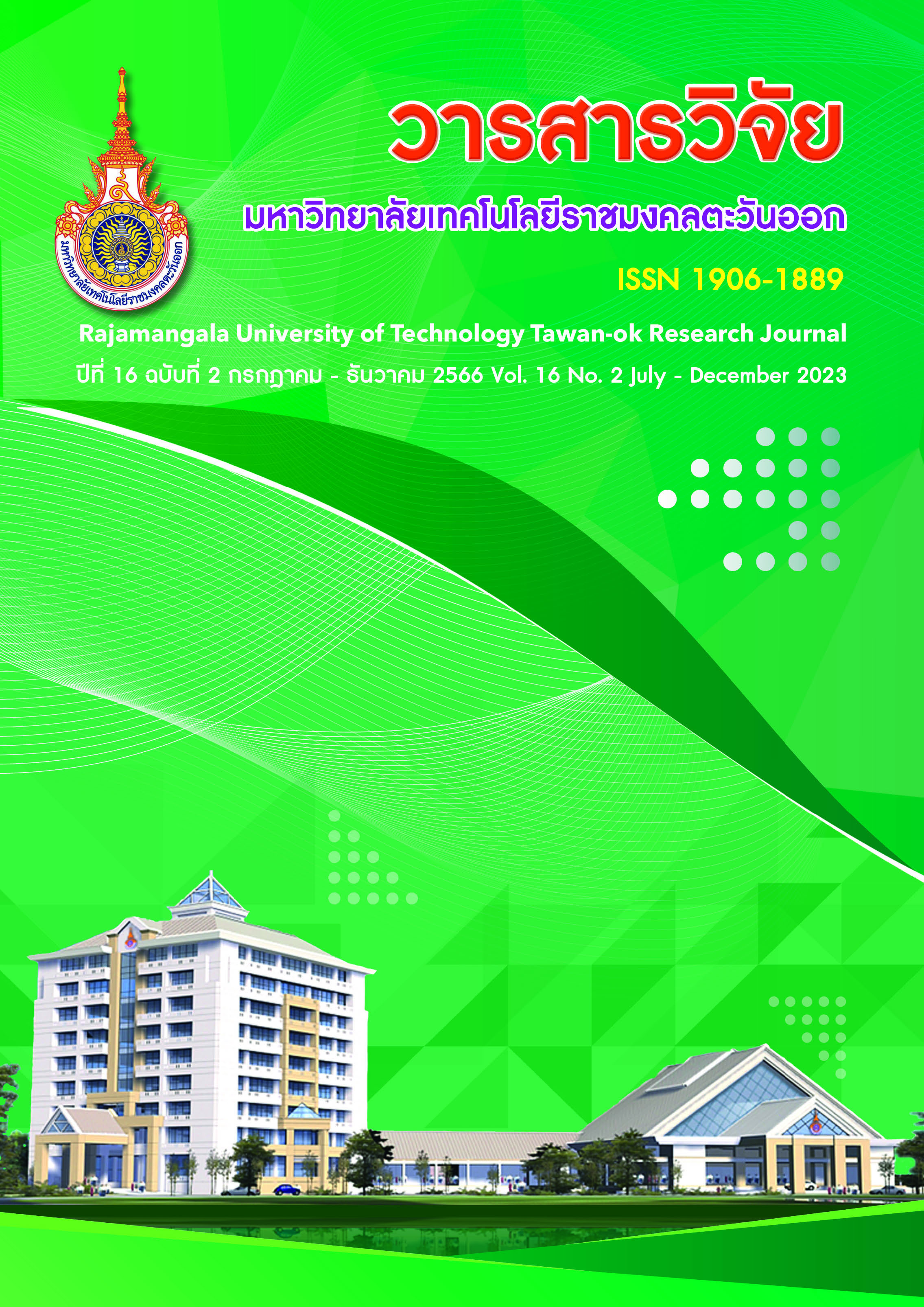Assessment of the Positional Accuracy of Digital Elevation Model Derived from Low-Cost UAV การประเมินความถูกต้องเชิงตำแหน่งของแบบจำลองระดับสูงเชิงเลขที่ผลิตจากอากาศยานไร้คนขับต้นทุนต่ำ
Main Article Content
Abstract
The objective of this research was to evaluate the positional accuracy of a digital elevation model derived from low-cost Unmanned Aerial Vehicle in the Recreation Park of Burapha University, Mueang district, Chonburi province using 6 ground control points and 24 checkpoints obtained through Real-Time Kinematic (RTK) surveys. The results indicated that the Root Mean Square. Error (RMSE) value at the confidence level of 95%, without using GCPs had a horizontal positional accuracy of 0.073-0.246 meters and a vertical positional accuracy of 0.270-0.429 meters. These values meet the standards set by the National Standard for Spatial Data Accuracy (NSSDA) and the American Society for Photogrammetry and Remote Sensing (ASPRS). Based on these results, the researchers recommend creating a photographic map at a scale of 1:4,000. Additionally, contour range data should be generated with a minimum interval of 100 centimeters. When GCPs were utilized in the process, the RMSE value at the confidence level of 95%, demonstrated the horizontal positional accuracy ranged from 0.054-0.093 meters, while the vertical positional accuracy ranged from 0.114-0.333 meters. These values also complied with NSSDA and ASPRS requirements, allowing for the creation of a 1:1,000 scale photographic map. Additionally, contour range data can be generated with a minimum interval of at least 50 cm. According to this study, digital elevation models from low-cost UAVs can be used both without and with GCPs for applications that do not require very detailed and precise verticality values, such as building elevation surveys, tree height, or the height of large billboards, etc., because the difference in elevation values between features within the study area is still within acceptable criteria.
Article Details

This work is licensed under a Creative Commons Attribution-NonCommercial-NoDerivatives 4.0 International License.
References
ASPRS. 2015. ASPRS Positional Accuracy Standards for Digital Geospatial Data. https://www.asprs.org/wp-content/uploads/2015/01/ASPRS_Positional_Accuracy_Standards_Edition1_Version100_November2014.pdf.
Daramola, O., Olaleye, J., Ajayi, O.G. and Olawuni, O. 2017. Assessing the Geometric Accuracy of UAV Based Orthophotos. South African Journal of Geomatics, Vol. 6, No. 3, pp. 395-406.
Engineering Institute of Thailand. (2018). Unmanned Aerial Survey Standards for Engineering. Bangkok. The Council of Engineers Thailand (COET). (in Thai)
Gindraux, S., Boesch, R., and Farinotti, D. (2017). Accuracy Assessment of Digital Surface Models from Unmanned Aerial Vehicle’ Imagery on Glaciers. Remote Sensing, 9, (2), 186.
Hamilton, S. 2017. UAV (drone) Aerial Photography and Photogrammetry and its Utility for Archaeological Site Documentation, Lakehead University. Available: http://www.apaontario.ca/resources/Documents/APA_OccasionalPaper2_DroneTesting_2017.pdf.
Hung, I.-K., Unge,r D., Kulhavy, D. and Zhang, Y. 2019. Positional Precision Analysis of Orthomosaics Derived from Drone Captured Aerial Imagery. Drones, No. 3, 46 pp.
Kanplumjit, T., Ketthong, W., Poonphakdee, N., Phrommet, S. 2020. Application of UAVs Surveying for Rock volume measurement at Khao Bandai Nang quarry Songkhla Province. NCCE25. 250:SGI04. Available from: https://conference.thaince.org/index.php/ncce25/article/view/611.
Koeva, M., Muneza, M., Gevaert, C., Gerke, M. and Nex, F. 2018. Using UAVs for Map Creation and Updating: A Case Study in Rwanda”, Survey Review. Vol. 50, No. 361, pp. 312-325.
Mantey, S. and Aduah, M. S. 2021. Assessment of Positional Accuracies of UAV-Based Coordinates Derived from Orthophotos at Varying Times of the Day- A Case Study. South African Journal of Geomatics, Vol. 10. No. 1, February 2021 DOI: http://dx.doi.org/10.4314/sajg.v10i1.4.
Nagendran, S. K., Tung, W. Y., & Mohamad Ismail, M. A. (2018). Accuracy assessment on low altitude UAV-borne photogrammetry outputs influenced by ground control point at different altitude. IOP Conference Series: Earth and Environmental Science, 169, 012031.
Laphitchayangkul. T., Pasada. A., Wangyao, K. 2020. Application of Low-cost Unmanned Aerial Vehicle for Accurate Mapping:Case Study at King Mongkut's University of Technology Thonburi, Ratchaburi. Residential College. KMUTT R&D Journal 3, 2020, 311-324.
Pix4D. 2021. Ground control points: why are they important?. Available from: https://www.pix4d.com/blog/why-ground-control-points-important.
Raczynski, R.J. (2017). Accuracy analysis of products obtained from UAV-borne photogrammetry influenced by various flight parameters. Master’s thesis, Department of Civil and Environmental Engineering, Norwegian University of Science and Technology. Norway.
Santise, M., Forlani, G. and Roncella, R. 2014. Evaluation of DEM generation accuracy from UAS imagery. The International Archives of the Photogrammetry, Remote Sensing and Spatial Information Sciences vol. XL-5, 2014, pp. 529-536.
Uysal, M., Toprak, A. S. and Polat, N. 2015. DEM generation with UAV Photogrammetry and accuracy analysis in Sahitler hil. Measurement : Elsevier, vol. 73, 2015, pp. 539-543.
Villanueva, J.K.S. and Blanco, A.C. 2019. Optimization of Ground Control Point (GCP) Configuration for Unmanned Aerial Vehicle (UAV) Survey using Structure from Motion (SfM). The International Archives of the Photogrammetry, Remote Sensing and Spatial Information Sciences, Vol. XLII-4/W12, 2019, pp. 167—174.
Volkmann, W. and Barnes, G. 2014. Virtual Surveying: Mapping and Modeling Cadastral Boundaries Using Unmanned Aerial Systems (UAS). XXV FIG Congress, Kuala Lumpur, Malaysia, June 16-21, 13pp.
Webster, C. W. 2018. Three-dimensional thermal characterization of forest canopies using UAV photogrammetry. Remote Sensing of Environment, vol. 209, 2018, pp. 835-847.
Wierzbicki, D., Kedzierski, M. and Fryskowska, A. 2015. Assessment of the Influence of UAV Image Quality on the Orthophoto Production. The International Archives of Photogrammetry, Remote Sensing and Spatial Information Sciences, Vol. 40, No. 1, 8pp.


